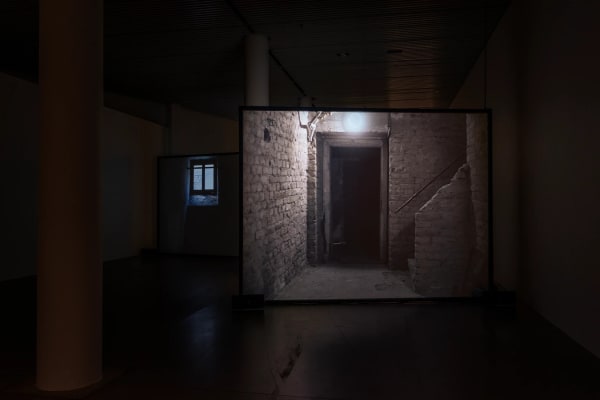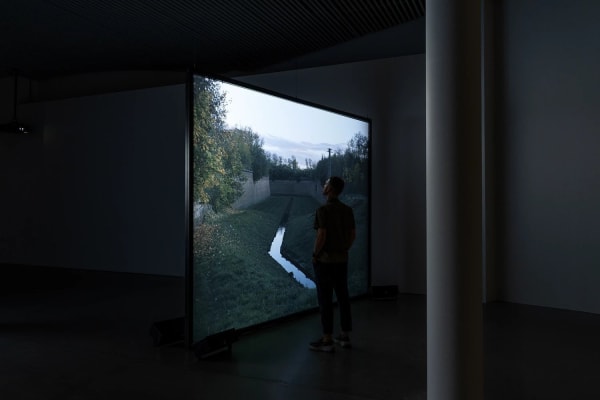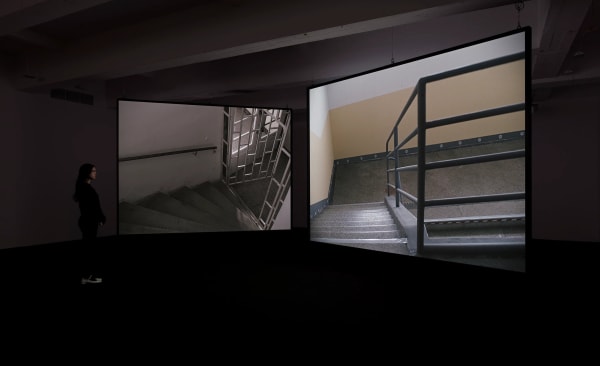In Study for Strings Sokol Terezín by Scottish artist Susan Philipsz, viewers are presented with a major new sound and video installation consisting of two isolated instruments – a cello and a viola – which are accompanied by two screens showing subtle footage of the hallways at the Theresienstadt concentration camp as they appear today.
The focal point of the piece is the sound of the two string instruments, which are originally part of the composition Study for String Orchestra, written by Czech-Jewish composer Pavel Haas (1899-1944). The piece was used as soundtrack for the Nazi propaganda film Theresienstadt: Ein Dokumentarfilm aus dem jüdischen Siedlungsgebiet from 1944, which was made with the purpose of presenting the German concentration camps as something completely different from the inhumane work and extermination camps they actually were. Haas was forced to compose the piece while imprisoned at Theresienstadt before being transferred to Auschwitz, where he, along with most other prisoners from Theresienstadt, was murdered.
Susan Philipsz brings the story of Pavel Haas and millions of other tragic personal stories into her artwork, utilizing sound fragments and video installations to place the horrors of the past in a contemporary context. In the ARoS exhibition, a camera moves through the buildings where Haas was imprisoned, as if the viewer was moving through the hallways as a ghost haunting the place where it once lived. At the same time, the sounds of the isolated instruments – the cello and the viola – fills the artwork, which gives the viewer a feeling of being both physically present in the room, while being mentally surrounded by memories, recollections, and thoughts. With this artwork, Philipsz explores themes such as distance and separation, absence and loss, as well as the importance of past events as we view history through our present perspective.
The sound establishes the framework for Susan Philipsz’ artworks. Throughout her career, Philipsz has deployed the ability of sound to define time and space, which she also does in the ARoS exhibition, actively affecting the viewer’s perception of the artwork, the room it is placed in, and the reality in which it has been created. By placing the composition in the original context – the hallways of Theresienstadt – she creates a compressed and uneasy atmosphere, which reminds us of the horrific events that make up the backdrop for the soundtrack.
The audio aspect of the artwork in the ARoS exhibition is part of Susan Philipsz’ former work, Study for Strings, which was presented at the Kassel train station in 2012. The train station in 2012 was an important piece of infrastructure during the Nazi reign in Germany, and the performance of the work in this particular setting is often characterized as Susan Philipsz’ chief work, as it received massive international recognition and attention.
The Nazi Wehrmacht captured about 500 Danish Jews, all of whom were sent to Theresienstadt. One year later in 1944, the central administration in Denmark succeeded in organizing a visit to the camp, during which the Red Cross was tasked with ensuring that Danish prisoners were being treated appropriately. The Nazi regime used this occasion and the visit from the Danish delegation to spread propaganda about the conditions in the camp – including the propaganda film Theresienstadt: Ein Dokumentarfilm aus dem jüdischen Siedlungsgebiet, which Susan Philipsz uses fragments of in her artwork.




